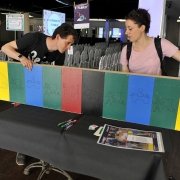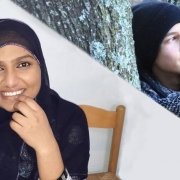Youth Center “Sale für Alle” (“Sale for everybody”)
Excerpt
The open youth center “Sale für Alle” (“Sale for everybody") combines the work of volunteers with the structure of an open youth center. The word "Sale" standsfor “Salesianum”, which is the place who has a more than 100-year-old history of working with children and youth. The Salesians of Don Bosco, with their preventive pedagogical system founded by Don Bosco, are among the pioneers of youth work. Located in the low-income and multicultural suburbs of Vienna, it is one of the most interesting meeting spaces for 80-100 migrant children and youths as well as 40-60 volunteers. Most of the volunteers are Austrian university students, who provide more than 80% of all working hours of the project as volunteers.
Narrative, origins and objectives of the initiative
What kind of project is this? Please give a short description (summary) of it.
“Sale für Alle” is a youth center in the suburbs of Vienna led by 40-60 volunteers.
Founded in 2009, it brings together:
- a) volunteers who work there for one afternoon per week
- b) children (6-14 years) and youth (14-23 years) from the neighborhood
Main activities:
- i) leisure activities (5x/week);
- ii) homework and learning groups (2x/week); and a neighborhood party (1x/year);
In Austria, there are two concepts of “out-of-school youth-work”: professional social workers in youth centers or street workers and/or volunteer-led-organisations like scouts, sport clubs, church-based organizations or others. The open youth center “Sale für Alle” (The “Sale for everybody") combines the work of volunteers with the structure of an open youth center. Located in the low-income and multicultural suburbs of Vienna, it is one of the most interesting meeting spaces for 80-100 migrant children and youths as well as 40-60 volunteers. The volunteers provide more than 80% of all working hours of the project. Most of them are Austrian university students, who want to become social workers, teachers or even IT engineers.
Challenges and opportunities of this experience turned out to be an interesting learning example for youth initiatives in other cities, especially for those who want to create common learning spaces and initiate social change.
The project was founded in 2009 and is coordinated by 3 social workers, who form the paid staff. They are part-time workers who work for a total of 56h/week (which is very low for such a huge project). Both groups – children and educators – come from different backgrounds, so for both groups it’s a permanent learning experience. Most of the other volunteer-led-organisations like scouts or sport clubs have clients and educators from the same social background, so their diversity is lower when compared to “Sale für Alle”.
A few of the challenges are that the volunteers need a lot of leadership training and ongoing formation, as reflection is crucial to enhance and sustain the quality of the work.
Opportunities are – besides the mutual learning described above – that some of the volunteers have already been part of the project for 9 years. In this way, volunteers contribute to train new volunteers who are getting the unique chance to interact in such a diverse space.
Please tell us why, in general, this project is considered a successful one?
- Youth centers are normally led by professional youth workers. This, however, is a volunteer-led youth center in a low-income neighborhood. Other volunteer-led organizations like scouts, sport clubs or church based organizations (e.g. Jungschar) deal with children or youth that have to go there and basically register themselves. At “Sale für Alle”, children just turn up, which makes it a really low-threshold service (“niederschwelliges Angebot”).
- In the last 10 years, “Sale für Alle” had more than 400 young volunteers (aged between 16-45 years), but some work with them for only one year. This fluctuation is a challenge, because they have new teams every year. However, this also makes the project one of the biggest volunteer places in Austria. At “Sale für Alle” a feeling of “Yes, we can be the change we want to see in the world” is experienced! This fills the place with growing energy.
.
And why would you consider it a grass-roots initiative?
“Sale für Alle” was initiated in 2009 from a student initiative as a concrete response to exclusion, xenophobia and a lack of opportunities for participation. It can therefore be considered a grass-root initiative. These students had enough of only discussing those topics, they wanted to do something about it. As a social movement it was very important for everybody to have an open-minded team with consent-based decision making processes.
What challenges needed to be solved in this project?
Challenges are – among other things – that the volunteers need a lot of leadership training and ongoing formation, so reflection is therefore crucial to enhance and sustain the quality of their work.
Another huge challenge is the fluctuation of the volunteers.
Is this initiative based on any particular theoretical framework? Which one?
Consent-based decisions are fundamental to Sales work. In Sales pedagogical work they consider themselves as part of the Austrian Network of open Youthwork “BOJA” and of the prevention concepts of “the first street worker” Don Bosco, who worked in Turin in the 19th century. Don Bosco was a priest who invented a “preventive system”: to care about young people before they start becoming criminals. (See also: http://www.sdb.org/en/don-bosco/24-profile-db/6-don-bosco-profile).
(Appendix) Is your intervention standing on its own or is it a part of a bigger and more holistic approach?
Please describe the group(s) intended as beneficiaries of this initiative
Why has this group (have these groups) been chosen?
"Sale für Alle" choose children and youth from a low income and migrant neighborhood as they have very little support in education. Many of the young children living there say: “I’m nobody, I will never achieve anything, and I’m just stupid.” The aim of "Sale für Alle" is to work on their self-esteem as well as their knowledge about how society is separated and marginalizes people. On the other side, "Sale für Alle" has volunteers coming from a completely different social background. For many of them it is the first time that they really interact with migrant or low-income families and their kids. This mutual learning is omnipresent, therefore it allows both target groups to fit together very well.
Could you please tell us something about the relative size of the (of each) target group, within the school/university population, region and/or country?
Children (6-14 years):
In the schools around the youth center there are 2000 children of that age, and 50 of them attend "Sale für Alle" weekly.
Youth (14-23 years):
It is difficult to say how many people of this age live in the neighborhood, but around 30 people of this age come to “Sale für Alle” weekly.
Which social characteristics are taken into account and what is the geographical area covered?
The neighborhood has mostly big houses (6 floors), and really few public areas.
Most of the children and youth that come to "Sale für Alle" were all born in Austria, but all of them have at least one parent who grew up in another country and/or has another mother tongue. "Sale für Alle" has 13-15 different mother tongues represented, but at the youth center they mainly communicate in German.
On which level is the project implemented?
Please describe the political and socio-economic factors that you believe have been important enablers for your initiative
Did the initiative have political support?
The Youth Center started in 2009. In the early years, there was a lot of volunteer work and the budget was low. In 2015 the city and the district started funding the project. In 2018 the center received two thirds of their budget from the city (“MA13 Außerschulische Jugendarbeit” and the 3rd district of Vienna). The other third of the budget came from the hosts of the indoor and outdoor areas, the “Don Bosco Salesians”, who also support "Sale für Alle" in various other ways.
How did it fit with local, regional or national policies?
It currently fits well in the general plan of the MA13 and in the network of Don Bosco Youth Centers in Austria. Nevertheless, for both partners "Sale für Alle" differs a bit from other projects, because, for example, other youth centers supported by the MA13 normally have no volunteers.
Who are the stakeholders supporting the initiative?
The main stakeholders supporting the initiative are MA13, the network of Don Bosco Youth Centers Austria, which are all very supportive. Beside them, there is also “Volontariat Bewegt”, which gives "Sale für Alle" the chance to get in contact with their returned volunteers (who have been in Mexico, India or Ghana for one year) and many of them are our strongest volunteers (staying in the project between 1-5 years).
Are there particular demographic changes present that are influencing the project?
"Sale für Alle" works in a low income district, so there are always young people who are happy to have such a place that they can come to. In addition, as the extreme rights are splitting the society with their xenophobic thoughts and actions, more and more people want to support initiatives like this to make a visible statement against xenophobia.
What is the institutional strategy and culture of the (educational) organization?
- Bringing together migrant children and youth with volunteers who mainly come from Austrian families (little migrant background). -> Enhance mutual learning between the target group and the volunteers.
- Empowering children and youth from the neighborhood in their growth and development.
- Breaking the “tradition”/stigma of being a suburban kid with no talents and no future.
To what extent does the initiative have an influence on institutional policy (or potential influence) of the (educational) organization?
Two schools are really close to "Sale für Alle", so in those schools "Sale für Alle" has the strongest impact.
(Appendix) Is there public support for your initiative and the issue it addresses?
(Appendix) What other factors do you think have been important for the success of this initiative?
Please describe the overall initiative design and the methods and tools used to reach the goals
Please describe the specific activities carried out.
- For children (6-14 years): i) leisure activities (3x/week); ii) homework and learning groups (2x/week); and iii) a neighborhood party (1x/year);
- For youth (14-23 years): i) leisure activities (2x/week)
What were the key roles (teacher, student, management team etc.) within the project?
The volunteers and the paid staff (3 persons) as social workers; a CEO for the inner and outer communication, planning and long-term strategies; 9 volunteers on the board.
What ideas, tools, theories, models, methodology (etc.) have been used to reach the goals?
- The social worker methods and strategies as defined by the Austrian Youth Network BOJA;
- Pedagogy by “the first street worker” Don Bosco, which greatly inspired "Sale für Alle";
- Paulo Freire and other theorists who wrote about overcoming oppression and injustice;
- Participation and empowerment of the target group as the main focus.
What are the final revenues of the project?
Please describe if your project ensured its sustainability
If so, how did you ensure the short-term impact of the project?
Continuous work and presence for the target group; strong relation to schools etc.
And how did you ensure the long-term impact of the project?
Establishing a strong and committed team; finding long-term funding partners.
Has your project been replicated elsewhere?
Please tell us about the resources used in this initiative
What was the budget for the initiative?
100.000 EUR / year
How much did the initiative depend on volunteers?
10.000 hours of volunteer work / year
How were the costs perceived by the public/the sector/other stakeholders?
To what extent did the initiative achieve its objectives?
Please describe the evidence to support the success of your initiative.
For each activity, "Sale für Alle" has an average of 32 children and/or 23 youth. During special events, they have up to 1.200 visitors in one day. These numbers have been stable since 2015.
Since 2009 "Sale für Alle" has seen many young children become adults, who gave the feedback that “Sale für Alle” had a strong and positive impact on their lives.
Did the intervention lead to any unintended (positive) outcomes?
The mutual learning between the volunteers and the target group is much bigger than "Sale für Alle" had ever expected.
What indicators (quantitative and qualitative) have you measured to demonstrate success?
"Sale für Alle" has the quantitative numbers of visitors. Until now they haven`t done any qualitative research with the target group. This is therefore a big goal for the years to come!

 Sale für Alle 2018
Sale für Alle 2018
 (C)E-Fabrik • G.de CROP
(C)E-Fabrik • G.de CROP



 Copyright: Camilla Pellech, Postgraduate Center der Universität
Copyright: Camilla Pellech, Postgraduate Center der Universität